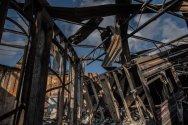These U.S. troops survived one of the greatest crises of the Trump era. A year later, they’re still coping.

The U.S. soldiers scrambled from one bunker to the next, stumbling past
charred wreckage, 30-foot-wide craters and puddles of diesel fuel. A
barrage of ballistic missiles had briefly knocked some of them unconscious, and more were on the way.
Maj. Alan Johnson struggled to focus after absorbing the monstrous blast waves of several explosions, including one that missed his bunker by about 60 feet, he recalled.
“I still have anxiety,” Johnson said.
“I still have recurring nightmares of incoming — just that sound of those things coming in.”
The United States stood at the precipice of full-scale war a year ago when
Iran launched [ballistic] 16 missiles at U.S. forces in Iraq.
in the western part of the country, another landed outside the northern city of Irbil, and four malfunctioned, the military said.
After months of escalating confrontation, Iranian-backed forces had laid siege to the U.S. Embassy in Baghdad about a week earlier. The Trump administration responded a few days later by launching a
in Baghdad that killed an Iranian general, Qasem Soleimani, a longtime U.S. nemesis.
Facing the gravest international security crisis of his presidency,
President Trump suddenly shifted gears. “All is well!” he tweeted within hours of the attack on Jan. 8, 2020.
A year later, service members who endured the attack described how close the United States and Iran came to greater calamity.
No U.S. troops were killed despite
Iran’s use of weapons that were each about 40 feet long and carrying 1,600 pounds of explosives, more powerful than any weapon launched at Americans in a generation.
But
110 survivors were ultimately diagnosed with traumatic brain injuries, some requiring long hospitalizations and intensive therapies at the Walter Reed National Military Medical Center outside Washington. The military disclosed the injures days after the strike, saying that an earlier Trump announcement that there were “no casualties” was based on the best information the Pentagon had at the time.
In reality,
29 service members, including Johnson, were injured seriously enough to receive Purple Hearts in the strike, which the Iranians called Operation Martyr Soleimani.
“I can’t think that anyone has walked away from this without some sort of effects, psychologically or emotionally, because of how traumatic the event was,” said Lt. Col. Johnathan Jordan, the operations officer for an Air Force unit present that night.
The airfield was quiet as midnight arrived — “almost like a ghost town,” said Tech. Sgt. Bryan Moody, part of an Air Force security forces team on duty.
Moody, a member of the Kentucky Air National Guard, and his colleagues drove around in a mine-resistant truck, making sure the base was secure. Other troops stood watch in guard towers, vigilant in case a ground attack also materialized, while nearly everyone else left on the base sheltered in place.
The warning rang out over loudspeakers after 1 a.m.: “Incoming! Incoming! Take cover!”
The first missile exploded at 1:34 a.m. about 100 yards from the mine-resistant vehicle that Moody’s team was driving, casting debris on the hood. Johnson, assigned to an Army aviation unit, huddled with soldiers in an aboveground shelter. With open-air sides and sandbags covering concrete, the bunker was designed to stop smaller rockets — not missiles.
Johnson has no recollection of the first three blasts and believes it is because the third briefly knocked him and other soldiers in his bunker unconscious. It had landed about 70 yards away.
The fourth exploded about 300 yards away. The fifth and sixth missiles whooshed in about 40 seconds later — one 120 yards away and the other just 60 feet.
Johnson tasted “ammonia-flavored moon dust” on his teeth before he lost consciousness again.
Four missile volleys lasted more than an hour, one coming about every 15 minutes.
During lulls in the barrage, their team and other security forces rushed to check on others on base.
Among those in need of help were
two soldiers trapped in a guard tower that was on fire, Moody said. A missile had landed nearby, and they were unable to climb down from their 12-foot-high perch because of the flames.
Elsewhere,
a contractor who suffered a serious eye injury needed help.
Even with the attack over for hours, there was little movement on the base at daybreak.
Levander said his crew’s CV-22 flew over the base early that morning.
Virtually no one had left their bunkers yet, and
hangars were still on fire, he said. When he and his colleagues returned to their living area, they found soap dispensers blown off walls, lights hanging askew, and electric generators that had stopped.
Soldiers who had survived in bunkers were hesitant to leave them, even after an “all clear” message went out.
Some were crying, Johnson said. Some were whimpering. Others were vomiting.
“The fact was, everyone had these symptoms of traumatic brain injury,” Johnson said. “But those symptoms were insignificant compared to what we went through all night.”
Service members began receiving testing afterward. Patients with the most significant symptoms were evacuated from Iraq. Johnson was diagnosed with a brain injury and spent weeks receiving physical therapy, speech therapy, occupational therapy, ocular motor therapy and psychiatric care in Germany. He eventually returned to the Middle East to complete his deployment.
Davenport and Moody said they did not suffer any injuries. But
they wonder how America moved on so quickly. “It’s kind of disheartening sometimes,” Davenport said. “Some people don’t even know it happened.”
A fascinating insight into the historic, direct military action by Iran against the USA from the occupying soldiers on the ground, which went unanswered by the US.
I would add that the article omits that the President of the US threatened in advance that if Iran were to strike at any US target (in retaliation for the illegal assassination of Iranian General Soleimani), the US would instantly respond with military strikes against 52 pre-selected Iranian sites, including historical heritage sites.
This, of course, did not happen: the US did not respond militarily at all - deterrence was restored.


